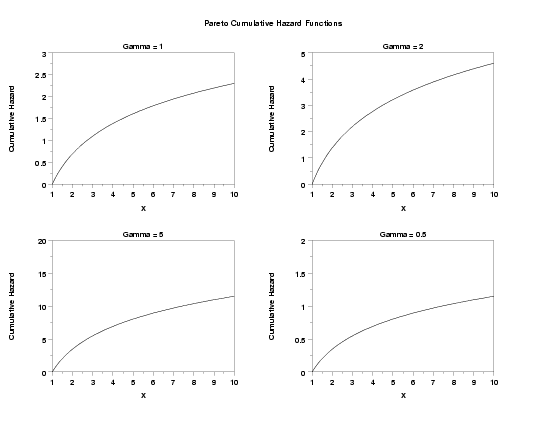

|
PARCHAZName:
 and a.
and a.

with Note that although the a parameter is typically called a location parameter (and it is in the sense that it defines the lower bound), it is not a location parameter in the technical sense that the following relation does not hold:

with H denoting the cumulative hazard function. For this reason, Dataplot treats a as a shape parameter. In Dataplot, the a shape parameter is optional with a default value of 1.
<SUBSET/EXCEPT/FOR qualification> where <x> is a variable, a number, or a parameter; <gamma> is a number or parameter that specifies the tail length shape parameter; <a> is a number or parameter that specifies the optional lower bound shape parameter; <loc> is a number or parameter that specifies the optional location parameter; <scale> is a number or parameter that specifies the optional scale parameter; <y> is a variable or a parameter (depending on what <x> is) where the computed Pareto cumulative hazard value is saved; and where the <SUBSET/EXCEPT/FOR qualification> is optional. The a, loc, and scale parameters are all optional.
LET A = PARCHAZ(3,1.5,2) LET Y = PARCHAZ,GAMMA,A,LOC,SCALE) PLOT PARCHAZ(X,GAMMA,A,LOC,SCALE) FOR X = XSTART 0.01 XSTOP

Most applications of the Pareto distribution use the standard form (location = zero, scale = one).
MULTIPLOT 2 2
MULTIPLOT CORNER COORDINATES 0 0 100 95
MULTIPLOT SCALE FACTOR 2
.
CASE ASIS
TITLE CASE ASIS
LABEL CASE ASIS
TITLE DISPLACEMENT 2
Y1LABEL DISPLACEMENT 15
X1LABEL DISPLACEMENT 12
Y1LABEL Cumulative Hazard
X1LABEL X
.
TITLE Gamma = 1
PLOT PARCHAZ(X,1) FOR X = 1 0.1 10
TITLE Gamma = 2
PLOT PARCHAZ(X,2) FOR X = 1 0.1 10
TITLE Gamma = 5
PLOT PARCHAZ(X,5) FOR X = 1 0.1 10
TITLE Gamma = 0.5
PLOT PARCHAZ(X,0.5) FOR X = 1 0.1 10
END OF MULTIPLOT
MOVE 50 97
JUSTIFICATION CENTER
TEXT Pareto Cumulative Hazard Functions

Date created: 8/23/2006 |